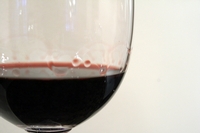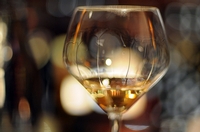Wine is a sensory pleasure. Of the five senses, smell and taste obviously come first in providing that pleasure. The tactile sensation of a wine in your mouth matters less, but it countsm too.
The other two senses, though, play only minor roles. If involved at all, what you hear bespeaks anticipation (rather than gratification). Think of the pop of a Champagne cork, and then the fizz when the wine is poured; those sounds can make your mouth water.
 Sight can provide similar pleasures. After all, a half-filled crystal glass is aesthetically attractive. Yet how a wine sounds or looks has very little to do with how it smells or tastes.
Sight can provide similar pleasures. After all, a half-filled crystal glass is aesthetically attractive. Yet how a wine sounds or looks has very little to do with how it smells or tastes.
That’s why no one talks much about listening to wine. What is surprising, however, is that people expend lots of energy talking about how wine looks. Why?
Many important professional wine competitions require that up to a quarter of a wine’s score (often five out of twenty points) be determined by sight. Virtually every “how to enjoy wine” book or article begins by advising the reader to analyze a wine’s appearance. And at virtually every wine class I’ve taught over the years, someone has raised a hand and asked about a wine’s “legs”—the viscous droplets on the inside of a glass, something experienced solely though sight, and something that has absolutely nothing to do with the pleasure provided by the senses of smell and taste. Why?
My guess is that the explanation has something to do with the wealth of words we have to detail what we see as compared to our language’s impoverished ability to describe what we experience via nose and mouth. With smell and taste, we often are reduced to bland subjective pronouncements, “I like it” becoming synonymous with “it’s good.”
 By contrast, with sight we can discriminate linguistically between subtle nuances of color, size, and shape, and so pretend to some semblance of objectivity. So phrases such as “it’s golden yellow,” or “the legs are thick,” or “it’s dark and opaque” seem to have less to do with individual preference and more to do with the wine itself.
By contrast, with sight we can discriminate linguistically between subtle nuances of color, size, and shape, and so pretend to some semblance of objectivity. So phrases such as “it’s golden yellow,” or “the legs are thick,” or “it’s dark and opaque” seem to have less to do with individual preference and more to do with the wine itself.
The problem is that golden yellow, thick legs or dark color, have virtually nothing to do with what really counts—how the wine smells and tastes. A golden wine may be evidence of oxidation, of wood aging, of skin contact, of the grapes themselves, and a host of other possibilities—so many that as objective evidence, it’s just about meaningless.
So, too, thick legs dripping slowly down the glass can come equally well from a rich, high alcohol wine and a lithe delicate one. And a dark wine can taste thin and watery just as a light-colored one can taste deep and rich.
The point is that how a wine looks is largely irrelevant. So don’t waste time thinking or talking about it. Instead, devote your words to your more important but admittedly more difficult to discuss senses. With wine, they’re what really matters.
4
